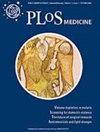Behavioral risk factors and socioeconomic inequalities in ischemic heart disease mortality in the United States: A causal mediation analysis using record linkage data
IF 9.9
1区 医学
Q1 MEDICINE, GENERAL & INTERNAL
引用次数: 0
Abstract
Background Ischemic heart disease (IHD) is a major cause of death in the United States (US), with marked mortality inequalities. Previous studies have reported inconsistent findings regarding the contributions of behavioral risk factors (BRFs) to socioeconomic inequalities in IHD mortality. To our knowledge, no nationwide study has been conducted on this topic in the US. Methods and findings In this cohort study, we obtained data from the 1997 to 2018 National Health Interview Survey with mortality follow-up until December 31, 2019 from the National Death Index. A total of 524,035 people aged 25 years and older were followed up for 10.3 years on average (SD: 6.1 years), during which 13,256 IHD deaths occurred. Counterfactual-based causal mediation analyses with Cox proportional hazards models were performed to quantify the contributions of 4 BRFs (smoking, alcohol use, physical inactivity, and BMI) to socioeconomic inequalities in IHD mortality. Education was used as the primary indicator for socioeconomic status (SES). Analyses were performed stratified by sex and adjusted for marital status, race and ethnicity, and survey year. In both males and females, clear socioeconomic gradients in IHD mortality were observed, with low- and middle-education people bearing statistically significantly higher risks compared to high-education people. We found statistically significant natural direct effects of SES (HR = 1.16, 95% CI: 1.06, 1.27 in males; HR = 1.28, 95% CI: 1.10, 1.49 in females) on IHD mortality and natural indirect effects through the causal pathways of smoking (HR = 1.18, 95% CI: 1.15, 1.20 in males; HR = 1.11, 95% CI: 1.08, 1.13 in females), physical inactivity (HR = 1.16, 95% CI: 1.14, 1.19 in males; HR = 1.18, 95% CI: 1.15, 1.20 in females), alcohol use (HR = 1.07, 95% CI: 1.06, 1.09 in males; HR = 1.09, 95% CI: 1.08, 1.11 in females), and BMI (HR = 1.03, 95% CI: 1.02, 1.04 in males; HR = 1.03, 95% CI: 1.02, 1.04 in females). Smoking, physical inactivity, alcohol use, and BMI mediated 29% (95% CI, 24%, 35%), 27% (95% CI, 22%, 33%), 12% (95% CI, 10%, 16%), and 5% (95% CI, 4%, 7%) of the inequalities in IHD mortality between low- and high-education males, respectively; the corresponding proportions mediated were 16% (95% CI, 11%, 23%), 26% (95% CI, 20%, 34%), 14% (95% CI, 11%, 19%), and 5% (95% CI, 3%, 7%) in females. Proportions mediated were slightly lower with family income used as the secondary indicator for SES. The main limitation of the methodology is that we could not rule out residual exposure-mediator, exposure-outcome, and mediator-outcome confounding. Conclusions In this study, BRFs explained more than half of the educational differences in IHD mortality, with some variations by sex. Public health interventions to reduce intermediate risk factors are crucial to reduce the socioeconomic disparities and burden of IHD mortality in the general US population.美国缺血性心脏病死亡率中的行为风险因素和社会经济不平等:利用记录关联数据进行因果中介分析
背景 在美国,缺血性心脏病(IHD)是导致死亡的主要原因之一,而且存在明显的死亡率不平等现象。关于行为风险因素(BRFs)对缺血性心脏病死亡率的社会经济不平等的影响,以往的研究得出了不一致的结论。据我们所知,美国尚未就这一主题开展过全国性研究。方法和结果 在这项队列研究中,我们从 1997 年至 2018 年的全国健康访谈调查中获得了数据,并从全国死亡指数中获得了截至 2019 年 12 月 31 日的死亡率随访数据。共对 524,035 名 25 岁及以上的人进行了平均 10.3 年(SD:6.1 年)的随访,其间有 13,256 人死于 IHD。利用 Cox 比例危险模型进行了基于反事实的因果中介分析,以量化 4 个 BRFs(吸烟、饮酒、缺乏运动和体重指数)对 IHD 死亡率的社会经济不平等的影响。教育程度是衡量社会经济地位(SES)的主要指标。分析按性别进行分层,并根据婚姻状况、种族和民族以及调查年份进行调整。在男性和女性中,都观察到了明显的社会经济梯度对心肌梗死死亡率的影响,与高学历人群相比,中低学历人群的风险在统计学上明显更高。我们发现,在统计学上,社会经济地位对 IHD 死亡率有明显的自然直接影响(男性:HR = 1.16,95% CI:1.06,1.27;女性:HR = 1.28,95% CI:1.10,1.49),并通过吸烟的因果途径产生自然间接影响(男性:HR = 1.18,95% CI:1.15,1.20;女性:HR = 1.11,95% CI:1.08,1.13)。13)、缺乏运动(男性 HR = 1.16,95% CI:1.14,1.19;女性 HR = 1.18,95% CI:1.15,1.20)、饮酒(男性 HR = 1.07,95% CI:1.男性的 HR = 1.07,95% CI:1.06,1.09;女性的 HR = 1.09,95% CI:1.08,1.11)和体重指数(男性的 HR = 1.03,95% CI:1.02,1.04;女性的 HR = 1.03,95% CI:1.02,1.04)。吸烟、缺乏运动、饮酒和体重指数分别介导了29%(95% CI,24%,35%)、27%(95% CI,22%,33%)、12%(95% CI,10%,16%)和5%(95% CI,4%,7%)低学历男性和高学历男性之间IHD死亡率的不平等;女性的相应调解比例分别为 16%(95% CI,11%,23%)、26%(95% CI,20%,34%)、14%(95% CI,11%,19%)和 5%(95% CI,3%,7%)。以家庭收入作为社会经济地位的次要指标时,中介比例略低。该方法的主要局限性在于,我们无法排除暴露-中介、暴露-结果和中介-结果的残余混杂因素。结论 在本研究中,BRFs 可解释一半以上的 IHD 死亡率教育差异,但也存在一些性别差异。减少中间风险因素的公共卫生干预措施对于缩小社会经济差距和减轻美国普通人群中心肌梗死死亡率的负担至关重要。
本文章由计算机程序翻译,如有差异,请以英文原文为准。
求助全文
约1分钟内获得全文
求助全文
来源期刊

PLoS Medicine
医学-医学:内科
CiteScore
21.60
自引率
0.60%
发文量
227
审稿时长
3 months
期刊介绍:
PLOS Medicine aims to be a leading platform for research and analysis on the global health challenges faced by humanity. The journal covers a wide range of topics, including biomedicine, the environment, society, and politics, that affect the well-being of individuals worldwide. It particularly highlights studies that contribute to clinical practice, health policy, or our understanding of disease mechanisms, with the ultimate goal of improving health outcomes in diverse settings.
Unwavering in its commitment to ethical standards, PLOS Medicine ensures integrity in medical publishing. This includes actively managing and transparently disclosing any conflicts of interest during the reporting, peer review, and publication processes. The journal promotes transparency by providing visibility into the review and publication procedures. It also encourages data sharing and the reuse of published work. Author rights are upheld, allowing them to retain copyright. Furthermore, PLOS Medicine strongly supports Open Access publishing, making research articles freely available to all without restrictions, facilitating widespread dissemination of knowledge. The journal does not endorse drug or medical device advertising and refrains from exclusive sales of reprints to avoid conflicts of interest.
 求助内容:
求助内容: 应助结果提醒方式:
应助结果提醒方式:


